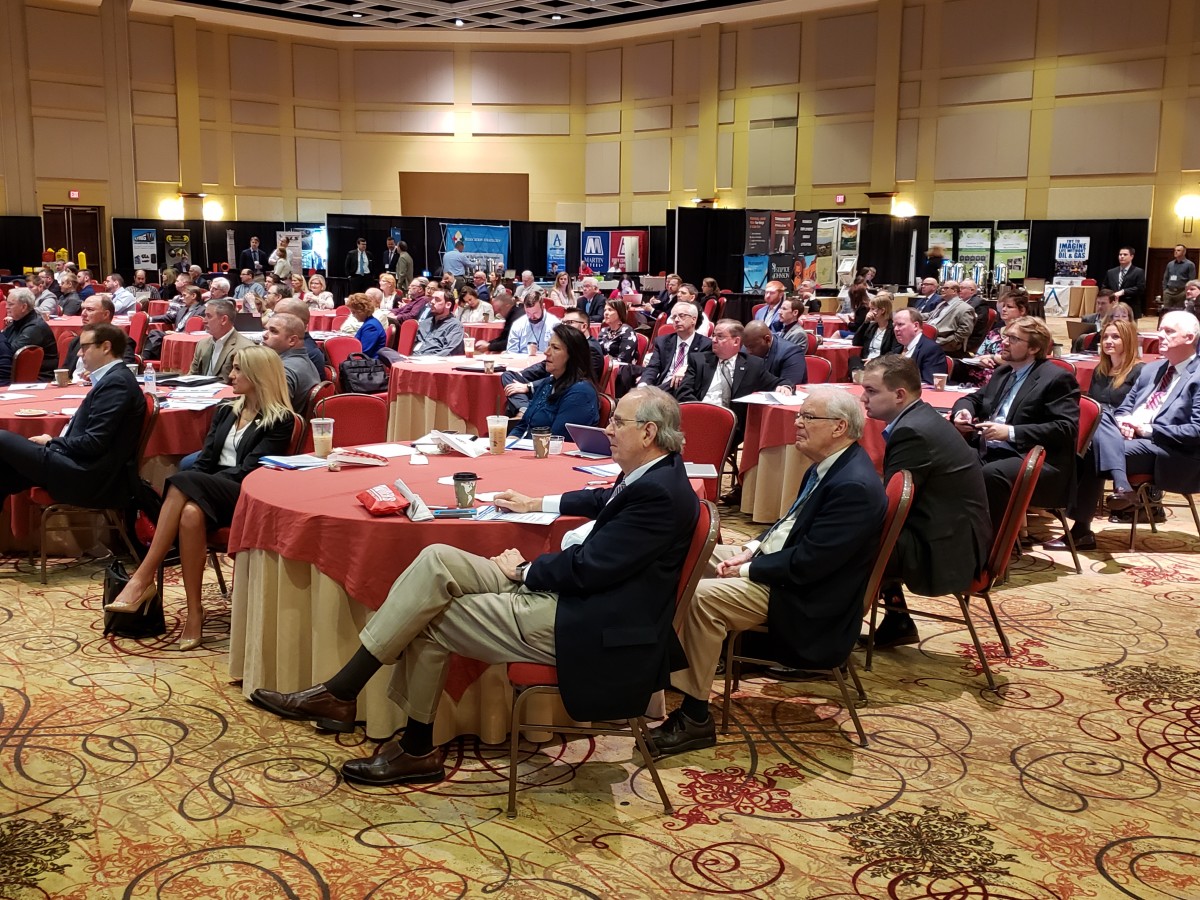MORGANTOWN — Natural gas industry representatives gathered in Morgantown Tuesday for the ninth annual West Virginia Manufacturers Association Marcellus and Manufacturing Development Conference.
Commerce Secretary Ed Gaunch opened the day on a high note, touching on the potential for the industry when downstream manufacturers begin to set up shop in the state. “Commerce wants to be a catalyst to make this happen.”

In a side conversation before he spoke he mentioned his optimism that a regional ethane storage hub, needed to supply the petrochemical industry with product could get under way within a few years.
Addressing the crowd gathered in the Marriott at Waterfront Place, he said, “The sun’s about to shine on this wonderful state. … Opportunities abound in West Virginia.”
— Steve Winberg, U.S. Department of Energy assistant secretary for fossil energy, addressed national energy priorities.
“West Virginia is not only wild and wonderful and beautiful, it’s a powerhouse,” he said. It’s important to use its abundant resources to benefit the nation and the world. That’s really the opportunity that lies before West Virginia and this broader region.”
He addressed the development of the Appalachian Basin ethane hub, which DOE supported in a 2018 report. The area can support up to five crackers to feed the petrochemical industry. That could lead to $35 billion in capital investment flowing into the region and 100,000 family wage, multigenerational jobs.
“What we’re going to do is everything in the government’s power to shine a bright light on this and get this over the finish line.” DOE has hired Ken Humphreys as WInberg’s senior advisor to make the hub a reality.
Although he was speaking to a gas crowd, Winberg spent some time talking about the industry’s somewhat friendly competitor, coal. DOE is pursuing “Coal FIRST” to build the coal plant of the future.
FIRST, he said, stands for flexible, innovative, resilient, small and transformative. It has to be able to ramp up and down quickly to fill in for intermittent renewables. It must achieve near zero emissions through carbon capture and utilization. It must be modular — easy to assemble — and high efficiency.
“This is a very important program that we’re rolling out and we’re looking forward to working with West Virginia on this.”
— Brian Anderson, director of the national Energy Technology Laboratory, told the crowd that NETL, with its three sites and 1,300 employees, is a hidden gem. “I don’t want it to be hidden anymore.”
NETL is leading a number of manufacturing initiatives, he said. “We want to ensure we have this innovation ecosystem that is robust and efficient.”
Fossil energy makes up 80 percent of the nation’s power supply, with natural gas about 29 percent of that he said. Renewables are about 11 percent. We will depend on fossil energy well into the balance of this century.
The eastern region and particularly the Appalachian Basin will lead the nation and the world in natural gas growth; the ethane supply for manufacturing will grow fourfold by 2025. The emerging downstream manufacturing markets could mean a $200 billion boon.
And that growth, he said, provides a “general opportunity” to grow and enhance national security, domestic jobs, GDP and energy independence.
— During a panel discussion, Wally Kandel, with the chemical firm Solvay, talked about the opportunities for the Ohio Valley Shale Crescent area. Shale Crescent USA markets shale opportunities in the three states.
They chose their name, he said, because Appalachia and Rust Belt carry negative connotations. “We need a shining bright new image that helps us do that.”
The Shale Crescent, he said, accounts for 85 percent of U.S. growth. It now makes up 32 percent of U.S. gas production and will contribute 45 percent by 2040. About 70 percent of polyethylene and 77 percent of polypropylene demand is within a day’s drive, so building here on top of the supply provides a cost advantage for manufacturers.
“These are really powerful things,” he said.
— John Deskins, director of WVU’s Bureau of Business & Economic Research, and Gideon Gradman, managing director at Baker Tilly Capital and founder of Integrated Energy Advisors, described a project designed to capitalize on the potential area petrochemical job market.
The industry has the potential for tens of thousands of jobs, Deskins said. “But we don’t know if that’s going to happen. … We can’t be complacent and not act.”
The idea of the project is to take every business that comes in — whether a few or a bunch — and place them into an economic development system. “This game-changing opportunity is so desperately needed.”
Gradman talked about the two-phase process for a manufacturer: site selection, permitting, construction, which lasts three to five years; and ongoing facility operation, which lasts 30-plus years.
Local and area businesses can provide thousands of support jobs — legal services, supplies, parts, IT and more — during both those phases, and the project would aim to connect those businesses with the anchor manufacturer.
— Renewables were the focus of one panel discussion. The demand for them is growing, the panelists acknowledged. And natural gas is the vehicle to allow for ongoing renewables growth.
Dave O’Brien, with ExxonMobil, explained why. Solar and wind are intermittent and lack quick ramp-up capacity to sustain the grid during emergencies or shortages. And battery storage technology is still inadequate.
Gas can supply the backbone to maintain the grid, he said. It can ramp up three to four times faster than coal, taking minutes instead of hours. This means renewables can operate and expand, with gas available as the go-to backup when renewables aren’t sufficient.
TWITTER @dbeardtdp Email David Beard at dbeard@dominionpost.com




